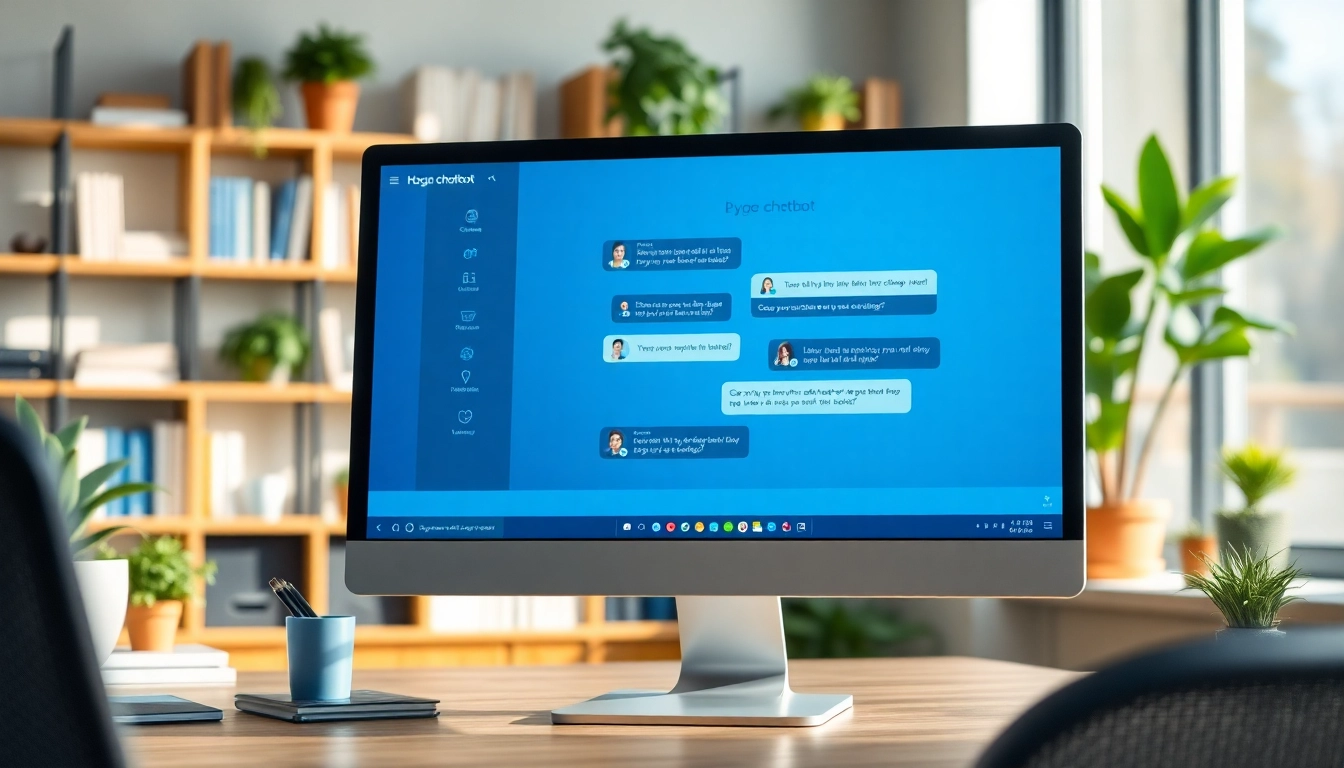Understanding the Fundamentals of ChatGPT Chatbots
What is a ChatGPT Chatbot?
A chatgpt chatbot is an advanced conversational interface powered by the GPT (Generative Pre-trained Transformer) architecture developed by OpenAI. These chatbots utilize large-scale language models to engage users in meaningful conversations, making them capable of understanding and generating human-like responses. Unlike traditional chatbots that rely on predefined scripts and rules, ChatGPT chatbots can learn from context, allowing for more dynamic and fluid interactions.
ChatGPT chatbots are designed to handle a variety of tasks ranging from customer support inquiries to providing educational information. Their adaptability stems from their training on diverse datasets, enabling them to comprehend natural language input and produce responses that are contextually relevant. As a result, businesses are increasingly turning to ChatGPT chatbots to improve their user engagement and streamline operations.
Key Features and Benefits
ChatGPT chatbots come equipped with several notable features that enhance their usability and effectiveness:
- Natural Language Understanding: The ability to comprehend and interpret user queries, including slang and idiomatic expressions.
- Context Awareness: Maintaining the context of a conversation over multiple exchanges, allowing for more cohesive interactions.
- Multilingual Capabilities: Support for multiple languages, which makes them suitable for global audiences.
- 24/7 Availability: Unlike human agents, chatbots can operate around the clock, providing instant support to users at any time.
- Scalability: Easily handles a large volume of inquiries, reducing wait times and enhancing customer satisfaction.
The benefits of implementing ChatGPT chatbots are equally compelling. Businesses can expect enhanced customer engagement, improved operational efficiency, and reduced costs associated with customer support. Furthermore, as these chatbots handle more queries, they gather valuable data that can inform business strategies and enhance user experiences.
How ChatGPT Chatbots Work
ChatGPT chatbots operate on a neural network model that processes language through multiple layers of transformation. Initially, the model is pre-trained on vast amounts of text data, learning grammar, facts, and some level of reasoning abilities. Once deployed, the chatbot interacts with users by employing various techniques and methodologies:
- Input Processing: When a user inputs a message, the chatbot preprocesses the text to understand its structure and meaning.
- Response Generation: Leveraging its extensive training, the chatbot generates a contextually appropriate response based on the user’s query.
- Feedback Loop: The chatbot learns and adapts its responses based on user feedback and interactions, allowing for continuous improvement.
This architecture allows ChatGPT chatbots to provide a coherent and engaging user experience, facilitating meaningful conversations. By harnessing the power of artificial intelligence, these chatbots redefine the customer interaction landscape, positioning businesses for success in an increasingly digital world.
Implementing ChatGPT Chatbots in Your Business
Identifying Use Cases for ChatGPT
Before integrating a ChatGPT chatbot into your business, it’s crucial to identify specific use cases where the chatbot can add the most value. Common applications include:
- Customer Support: Addressing common queries, troubleshooting issues, and providing product information can greatly enhance the customer experience.
- E-commerce Assistance: Helping customers navigate through the buying process, providing personalized recommendations, and facilitating transactions.
- Lead Generation: Engaging website visitors to gather information and qualify leads based on their responses.
- Feedback Collection: Gathering customer insights and feedback to improve products and services effectively.
- Education and Training: Providing informative responses in educational settings to assist users in learning new concepts.
Identifying the right use case is foundational as it will dictate the design and functionality of your chatbot. Tailoring the bot to meet specific business goals ensures it aids in enhancing user satisfaction and operational efficiency.
Steps to Integrate ChatGPT Chatbots
Once potential use cases have been established, the next step is to integrate a ChatGPT chatbot into your business operations. This process typically involves several key steps:
- Define Objectives: Clearly outline what you want to achieve with the chatbot. This can range from reducing response times to enhancing customer engagement.
- Select a Platform: Choose a development platform that supports ChatGPT capabilities. Options include cloud services from companies like OpenAI, as well as various chatbot management tools.
- Design Conversations: Map out conversation flows that align with user needs. Consider the types of questions users may ask and how the chatbot should respond.
- Implementation: Integrate the chatbot into your website or application. Make use of APIs and SDKs provided by the platform you’ve chosen.
- Test Extensively: Before going live, conduct thorough testing to ensure the chatbot operates as expected and provides value to users.
- Monitor and Iterate: Once live, continuously monitor chatbot interactions, gather feedback, and refine responses to improve performance.
Adhering to these steps will ensure a structured and efficient integration process, laying a solid foundation for your chatbot’s success.
Common Challenges and Solutions
Integrating a ChatGPT chatbot can be met with various challenges. Understanding these potential issues and their solutions will facilitate a smoother implementation:
- Understanding User Intent: One common challenge is the chatbot’s ability to accurately discern what users intend with their queries. To overcome this, employ robust training data and continuously fine-tune the model based on real user interactions.
- Managing Expectations: Users may expect human-like interactions. Clearly communicate the capabilities and limitations of the chatbot to set realistic expectations.
- Integration with Existing Systems: Compatibility issues can arise with existing software. Ensure that your chosen platform has integration capabilities with your current tech stack.
- Security Concerns: Safeguarding user data is paramount. Implement robust security measures to protect user interactions and ensure compliance with data protection regulations.
Identifying these challenges early on and preparing solutions will help in executing a successful ChatGPT chatbot strategy.
Optimizing Your ChatGPT Chatbot for Performance
Leveraging User Feedback for Improvements
One of the most valuable resources for optimizing a ChatGPT chatbot is user feedback. Regularly reviewing feedback allows businesses to understand user pain points, preferences, and improvement areas. Here are effective strategies for leveraging feedback:
- Incorporate Feedback Mechanisms: Integrate options for users to rate their interactions or provide comments after each session.
- Analyze Interactions: Regularly review chat logs to identify common issues or recurring queries that may indicate gaps in responses.
- Engage Users: Periodically survey users to gather insights on their experiences and satisfaction levels.
Utilizing this information not only enhances the chatbot’s performance but also reinforces the value placed on user input, fostering stronger customer relationships.
Setting Performance Metrics
To gauge the effectiveness of a ChatGPT chatbot, businesses must establish clear performance metrics. These metrics will help measure success and identify areas for improvement. Key performance indicators (KPIs) to consider include:
- Response Time: The average duration it takes for the chatbot to respond to user inquiries.
- User Satisfaction Score: Measuring user satisfaction through post-interaction surveys or ratings.
- Engagement Rate: The percentage of users who interact with the chatbot versus those who visit the site or app.
- Resolution Rate: The percentage of inquiries resolved without the need for human intervention.
- Retention Rate: Tracking the number of returning users interacting with the chatbot over time.
By setting and monitoring these KPIs, businesses can evaluate the impact of their ChatGPT chatbot and ensure it aligns with broader organizational goals.
Best Practices for Continuous Optimization
Continuous optimization is essential for maximizing the benefits of ChatGPT chatbots. Here are several best practices to keep in mind:
- Regular Updates: Continuously update the chatbot with new information and data, ensuring it remains relevant and accurate.
- Refine Training Data: Periodically review and enhance the training datasets used to improve the model’s understanding of evolving language patterns.
- Monitor New Technologies: Stay abreast of innovations and improvements in AI and machine learning that could enhance chatbot capabilities.
- Cross-Department Collaboration: Involve different departments (e.g., customer service, IT, marketing) in optimizing the chatbot’s functions.
Embracing these best practices will promote a proactive approach to maintaining chatbot performance and relevance in an ever-evolving digital landscape.
Analyzing Chatbot Interactions for Insights
Data-Driven Decisions from Chatbot Analytics
Analytics play a crucial role in understanding and enhancing the performance of ChatGPT chatbots. By analyzing interaction data, businesses can make informed decisions that impact future strategies:
- Identify Trends: Analyze common user requests and identify emerging trends to tailor content and services accordingly.
- Gauge Bot Performance: Use analytics to review how well the chatbot performs against established KPIs.
- Segment Users: Categorize users based on behavior and preferences to create tailored interactions and personalized experiences.
Ultimately, data-driven decisions enable businesses to harness insights that lead to effective adjustments, resulting in better user experiences.
Enhancing User Engagement through Insights
Insights derived from chatbot interactions can drastically enhance user engagement by informing how content and conversation flows are designed. Strategies include:
- Personalization: Customize responses based on user history, preferences, and previous interactions to create a more engaging experience.
- Proactive Interactions: Use data to anticipate user needs and proactively engage users, offering assistance before they even ask.
- Content Modification: Adaptively alter conversation scripts based on the analytics findings to maintain relevance and interest.
By focusing on data-driven insights, businesses can cultivate deeper connections with their audience and drive more significant engagement outcomes.
Case Studies of Successful ChatGPT Implementations
Real-world case studies provide powerful examples of how businesses have successfully implemented ChatGPT chatbots to meet specific needs. Consider the following:
- E-Commerce Brand: An online retailer used ChatGPT chatbots to assist customers in product selection and answer inquiries. As a result, they reported a 30% increase in conversion rates due to reduced customer drop-off during the buying process.
- Healthcare Provider: A healthcare institution deployed a ChatGPT chatbot to handle appointment scheduling and provide basic health information. Patient feedback indicated a marked improvement in satisfaction scores, mainly because they could quickly access information 24/7.
- Travel Agency: A travel agency integrated ChatGPT chatbots to assist users in booking trips. The chatbot’s ability to respond to inquiries in real-time resulted in a significant decrease in the average response time, improving overall operational efficiency.
These case studies highlight the potential of ChatGPT chatbots to drive tangible results, demonstrating their value across various sectors.
The Future of ChatGPT Chatbots in Customer Engagement
Expected Trends in Chatbot Technology
The future of ChatGPT chatbots is poised for transformative changes driven by advancements in AI technology. Anticipated trends include:
- Hyper-Personalization: Future chatbots will leverage advanced analytics to provide even more personalized experiences tailored to individual preferences and historical interactions.
- Emotion Recognition: Emerging technologies aim to integrate sentiment analysis capabilities, allowing chatbots to detect user emotions and respond empathetically.
- Increased Integration: As businesses adopt multichannel communication strategies, ChatGPT chatbots are expected to integrate seamlessly with various platforms, providing a unified customer experience.
- Voice Interaction Capabilities: The incorporation of voice-based interactions will become more prevalent, allowing users to engage with chatbots through spoken dialogue.
These trends hint at a more sophisticated and user-centric future, where ChatGPT chatbots play an even more significant role in shaping customer engagement strategies.
Preparing for Future User Expectations
As technology evolves, so too do user expectations. Businesses must remain vigilant and adaptable to meet these changing demands:
- Stay Current with Technology: Keep up with the latest advancements in AI and chatbot technology, ensuring your systems incorporate cutting-edge solutions to meet user expectations.
- Focus on Multimodal Experiences: Prepare for users who wish to engage through various channels, including text, voice, and even visual inputs.
- Deliver Consistent Experiences: Ensure that user interactions are consistent across all platforms, fostering trust and reliability.
By proactively preparing for future needs, businesses can create a roadmap for success, staying ahead of the curve in an ever-evolving landscape.
Building a Sustainable Chatbot Strategy
Finally, a sustainable chatbot strategy is essential for long-term success. To achieve this, businesses should:
- Invest in Continuous Learning: Ensure that both the chatbot and the team managing it participate in ongoing learning programs to stay on top of trends and best practices.
- Evaluate Performance Regularly: Conduct routine assessments of the chatbot’s performance against the KPIs established, making adjustments as needed based on analytics.
- Foster User Relationships: Maintain an open line of communication with users, gathering their insights and feedback as part of the improvement cycle.
By adopting a forward-thinking approach and prioritizing sustainability, organizations can navigate the rapidly changing landscape of customer engagement with ChatGPT chatbots effectively.








